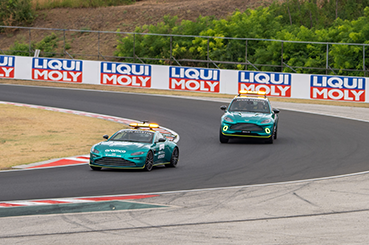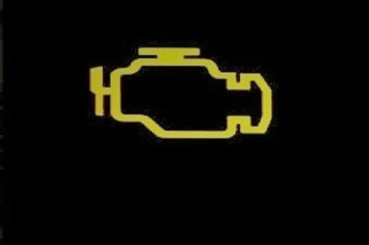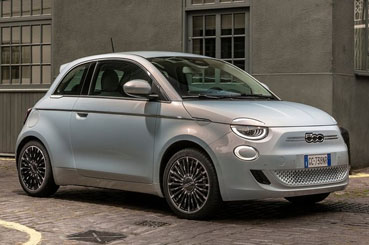The F1 Safety Car, a high-performance machine with flashing lights, is a crucial element in keeping Formula One races safe and unpredictable. But how did this concept come about, and how has it evolved over the years? Buckle up, race fans, as we delve into the fascinating history of the Safety Car in F1.
What is the F1 Safety Car?

The F1 Safety Car is a high-performance vehicle deployed onto the racetrack during times of danger or debris. Acting as a mobile caution flag, it leads the pack of cars around the circuit at a controlled speed. This allows marshals to safely remove obstacles or attend to incidents without putting themselves or the drivers at risk.
The Safety Car also plays a significant role in race strategy, as lapped cars can be shuffled around the field depending on when they pit for new tyres under the Safety Car’s lead.
More than just a guardian of safety, the F1 Safety Car has become an integral part of the racing experience, adding a layer of strategic complexity and unpredictable drama to Formula One.
When was the Safety Car first introduced to F1?
Believe it or not, the Safety Car’s debut was a baptism by fire. The year was 1973, and the Canadian Grand Prix was marred by torrential rain and treacherous track conditions.
To control the chaos and ensure driver safety, race officials made a daring decision – to deploy a Porsche 914 (a small sports car, more suited for weekend drives than leading an F1 pack) as the first-ever Safety Car.
Piloted by former Canadian racer Eppie Wietzes, the move aimed to neutralise the situation and allow marshals to clear debris. Unfortunately, things got messy. The Safety Car, lacking clear protocols and communication systems, picked up the wrong leader, causing confusion and leaving most of the field a lap down.
Sorting out the winner took hours, with Peter Revson eventually taking the checkered flag. This chaotic debut highlighted the need for a more formalised and well-defined Safety Car procedure in F1.
1980s and 1990s – Formalisation and High-Performance Takeover
The 80s and 90s saw a significant shift towards a more formalised approach to the Safety Car. Recognising the limitations of the ad-hoc system from the 70s, F1 officials implemented designated vehicles with proper lights and markings.
These early Safety Cars in the 80s, often high-performance cars like the Porsche 911 and occasionally a Lamborghini Countach, ensured better visibility on track and clearer communication with drivers during incidents.
However, the use of the Safety Car in Formula 1 occurred during the 1993 season, following successful trial deployments at the 1992 British and French Grand Prix. This period witnessed a diverse range of vehicles leading the field, including the FIAT Tempra in Brazil (1993), the Ford Escort Cosworth in Britain (1993), the Honda Prelude in Japan (1994), and even the Renault Clio in Argentina (1996).

Yet, a pivotal shift occurred in mid-1996, establishing a precedent that continues to this day. Through a collaborative agreement, Formula 1 partnered with Mercedes-Benz, entrusting the German marque with the exclusive provision of the Official Safety Car for all races. This marked the beginning of the “Mercedes Safety Car era,” commencing with the utilisation of the Mercedes-Benz C36 AMG in 1996 and extending throughout the 1997 season. Subsequently, the more powerful CLK 55 AMG was introduced for the 1998 and 1999 campaigns.
This period also saw the introduction of stricter protocols for Safety Car deployment, ensuring its use only in specific situations like accidents, debris, or extreme weather conditions. The Safety Car’s role in maintaining a safe racing environment became more widely accepted, and its impact on race strategy began to be explored by teams.
The 2000s – When Safety Met Style
The 00s brought a touch of aerodynamic flair with the introduction of Mercedes-Benz’s gull-winged SLS AMG as the Safety Car from 2010 to 2014. This marked a turning point, showcasing a Safety Car that wasn’t just about functionality but also about aesthetics.
The gull-wing doors became a signature element, adding a touch of drama and excitement to Safety Car appearances. The baton was later passed to the sleek Mercedes-AMG GT S-models, continuing the trend of high-performance Safety Cars that could keep pace with the ever-evolving F1 machines.
These powerful machines boasted advanced features like medical equipment on board, further solidifying the Safety Car’s role as a crucial element in ensuring driver well-being.
Who Drives the F1 Safety Car?
Since 2000, the legendary Bernd Mayländer has been the face (or should we say helmet?) of the F1 Safety Car team. His experience and skill are crucial in effectively managing on-track incidents.
A former racing driver himself, Mayländer understands the delicate balance between safety and competition. His calm demeanour and precise driving ensure that the Safety Car does its job efficiently, neutralising situations without compromising the competitive spirit of the race.
How fast does the F1 Safety Car go?
The Safety Car doesn’t exactly tear up the track, but it’s no slouch either. It typically maintains a speed that allows drivers to keep their tyres and brakes at optimal temperatures while also bunching up the field for a thrilling restart. This creates a strategic dance between the Safety Car and the drivers.
Running too slow could lead to cold tyres, compromising grip on the crucial restart. However, going too fast could put unnecessary stress on the tyres, potentially leading to failures later in the race. Mayländer, in collaboration with race control, navigates this delicate balance, ensuring a safe and competitive environment for the drivers.
Can lapped cars take over the Safety Car?
This is a strategic mind game that adds another layer of complexity to F1 races! Lapped cars are generally not allowed to overtake the Safety Car until the leader has done so. This creates a situation known as the “lap trap,” where lapped cars are stuck behind the Safety Car, potentially losing crucial positions.
However, it also presents a tactical opportunity for teams to pit their drivers for fresh tyres under the Safety Car, hoping to gain an advantage on the non-lapped cars who might stay out on older tyres.
This strategic gamble can make or break a race, and the decision to pit or stay out under the Safety Car is a crucial one for teams and drivers alike.
A Look Ahead: The Aston Martin Vantage
In the 2020s, Mercedes-Benz continued to provide the AMG GT R as the Official Safety Car. However, the 2021 season ushered in a period of significant modifications. In a move designed to enhance driver visibility during adverse weather conditions, the traditionally silver Safety Car livery was replaced with a striking red colour scheme.

Furthermore, a historic shift occurred as Mercedes-Benz relinquished exclusive control of the Safety Car duties for the first time. Since 2021, the Aston Martin Vantage has been stationed alongside the Mercedes in the pit lane, signifying a collaborative approach to on-track safety.
The Aston Martin Vantage, a high-performance sports car known for its aerodynamic prowess and elegance, is set to take the reigns as the official Safety Car. Boasting the latest safety features and enough horsepower to keep pace with the high-octane world of Formula One, the Vantage is a fitting successor to the legacy of Safety Cars. Additionally, the car will likely be equipped with advanced medical equipment on board, further solidifying the Safety Car’s role as a guardian angel on the track.
This shared responsibility extends to the driver’s seat, with Bernd Mayländer now piloting either the Aston Martin Vantage or the Mercedes-AMG GT Black Series.
The F1 Safety Car has come a long way from its chaotic debut in the 70s. It has evolved into a sophisticated machine that plays a critical role in maintaining a safe and exciting racing environment. As F1 technology continues to advance, so too will the Safety Car, ensuring that the sport pushes the boundaries of speed and performance while always prioritising the well-being of drivers.




